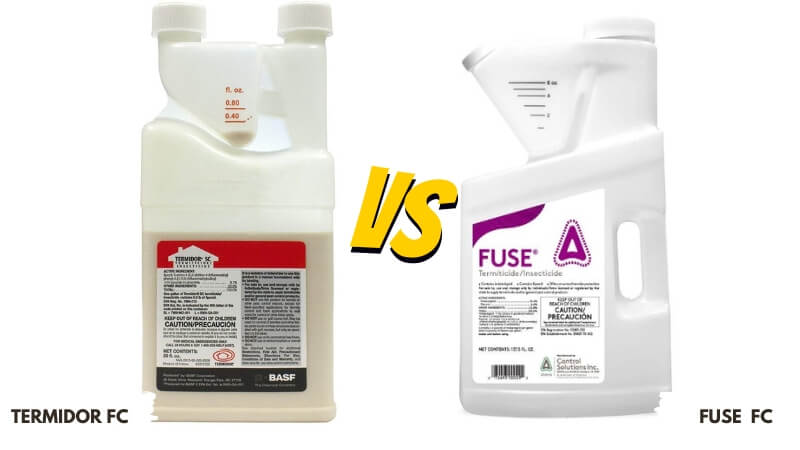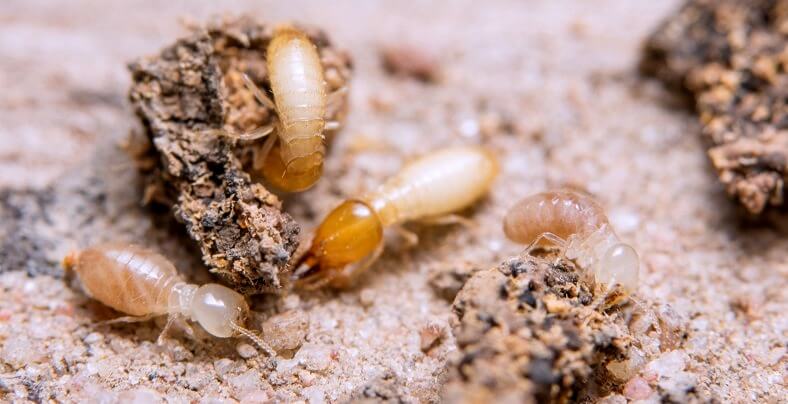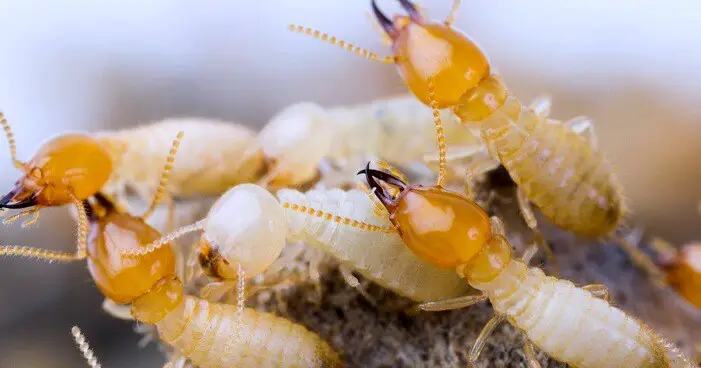Fuse vs Termidor For Termites

One main difference between Fuse and Termidor SC is their active ingredient concentrations. Fuse contains Fipronil at 6.6% and Imidacloprid at 21.4%, while Termidor SC contains Fipronil at a higher concentration of 9.1%. This difference in active ingredient concentration may impact their effectiveness and duration of pest control.
Fuse vs Termidor Table
This table is designed to assist you in deciding which option is preferable and the reasons behind it.
Fuse SC | Termidor SC |
Active ingredients Fipronil and Imidacloprid | Active Ingredient Fipronil 9.1% |
Two packaging options: 1 Quart & 128 Ounces. | Termidor SC comes in a 20-ounce container |
Primarily intended for outdoor use. Indoor usage is limited to spot treatments. | Primarily intended for outdoor use. Indoor usage is limited to spot treatments. |
Recommended ratio is 27.5 oz per 100 gallons of water | Mixing ratio for termite control is 0.80 oz per gallon of water. |
8 Year Promises Of Protection Warranty | Protects Homes For Up To 10 Years |
Non-repellent, meaning insects cannot detect it and will readily come into contact with it. Moreover, termites transport it back to their colony, resulting in extensive pest control. | The "Transfer Effect" technology in Termidor allows it to spread throughout termite or ant colonies, effectively eliminating all pests. |
Effective against a broad range of pests, including ants, boxelder bugs, European earwigs, millipedes, pill bugs, silverfish, and termites | Effective against other pests such as nuisance ants, spiders, cockroaches, paper wasps, earwigs, millipedes, and other pests. |
Active Ingredients
The Fuse contains two active ingredients: Fipronil at a concentration of 6.6% and Imidacloprid at 21.4%. These ingredients work on different aspects of insects’ nervous systems. Specifically, Imidacloprid targets the post-synaptic nicotinic acetylcholine receptors in the insect’s nervous system, leading to paralysis and death.
On the other hand, Fipronil, also present in Termidor SC at a concentration of 9.1%, inhibits the post-synaptic gamma-aminobutyric acid (GABA) receptors, disrupting the insect’s nervous system and resulting in death.

Duration of Effectiveness
Both Fuse and Termidor SC offer a long-lasting solution against pests. According to its manufacturers, Fuse provides effective pest control for up to 8 years, making it a highly durable choice.
Termidor SC provides a slightly longer duration of protection, lasting up to 10 years in the soil. This makes them both suitable for long-term pest control strategies.
Non-Repellent Nature
Both Fuse and Termidor SC are non-repellent, meaning they don’t deter pests but instead kill them. This non-repellent nature allows the insects to come into contact with the pesticide without detecting its presence, inadvertently ingest it, and spread it to other colony members, thereby ensuring effective pest control.
Spectrum of Pest Control
Fuse is effective against various pests, including ants, boxelder bugs, European earwigs, millipedes, pill bugs, silverfish, and termites. This broad-spectrum control makes it a versatile solution for various pest issues.
On the other hand, while Termidor SC is primarily known for controlling termites, it is also effective against other pests such as nuisance ants, spiders, cockroaches, paper wasps, earwigs, millipedes, and other pests.

Usage
Both Fuse and Termidor SC are primarily intended for outdoor use. Their indoor usage is limited to spot treatments for live termite infestations. These products should not be used directly on pets, emphasizing their use strictly for pest control.
Application Frequency
Fuse allows up to eight perimeter applications in the first year, which provides flexibility for ongoing pest management.
However, the application frequency for Termidor SC is not specified in the provided information, suggesting that users should follow the specific instructions on the product label.
Packaging Options
Termidor SC comes in a 20-ounce container, which can create up to 24 gallons of mixed solution, offering ample quantity for large-scale applications.
Fuse, however, provides two packaging options: 1 Quart and 128 Ounces, allowing customers to choose the most appropriate size.

Mixing Ratios
Both Fuse and Termidor SC require mixing with water before application. For Termidor SC, the mixing ratio for termite control is 0.80 oz per gallon of water.
For Fuse, the recommended ratio is 27.5 oz per 100 gallons of water for a termite barrier and 0.3 – 0.6 oz per gallon of water for an insect barrier.
Low Odor
Termidor SC is known for its low water solubility and low odor. These characteristics make it easy to handle and apply without causing discomfort due to strong smells. Additionally, Termidor SC does not damage water-safe surfaces, making it a reliable choice for a wide range of environments.
Like Termidor SC, Fuse also has a low odor, making it user-friendly. Furthermore, Fuse is suitable for preventative and curative applications, offering a comprehensive solution for termite and insect control. This versatile product can be used as a proactive measure to prevent infestations or as a reactive measure to eradicate existing pest populations.
Our Observation
Both Fuse and Termidor SC present commendable attributes for pest control. However, for a broad-spectrum, versatile solution, Fuse, with its dual active ingredients targeting diverse pests, is impressive.
Fuse’s application frequency, allowing up to eight perimeter applications in the first year, provides flexibility for robust pest management. Its packaging options also offer a degree of customization based on user needs.
However, Termidor SC stands out in terms of longevity, providing effective control for up to ten years in soil compared to Fuse’s eight years. Also, its lower mixing ratio for termite control signifies less product use per application. The choice between Fuse and Termidor SC ultimately depends on the specific pest issue and the long-term pest control strategy of the user.

James E. Butkovich, Pest control maven with a knack for eco-friendly & Chemical solutions. Blogger with a mission to make homes pest-free, one post at a time.

